Seagate's New Barracuda 3TB (ST3000DM001) Review
by Anand Lal Shimpi on November 2, 2011 11:00 PM ESTPlatter density has been the crutch of hard drive makers in recent history. Increasing spindle speeds can reduce random access latency, but at the expense of cost and thermals. Improvements in random access performance via increasing spindle speed pale in comparison to what is possible with solid state storage, not to mention that driving motors at speeds beyond 10,000 RPM becomes quite difficult. The focus on increasing platter density is also difficult, but higher density platters can actually lead to reductions in power consumption rather than the opposite (through a reduction in the number of platters per drive). There's also the fact that if you can cram more data on a single platter there's a direct impact on sequential accesses.
Yesterday Seagate announced its transition to 1TB platters with its new 7200RPM-only Barracuda line. The move marked a significant change for Seagate as it is phasing out the Barracuda Green brand, and shifting the focus of the high-performance Barracuda XT. The Barracuda Green was a rebrand of Seagate's Barracuda LP, designed to convey the lower power consumption enabled by its 5900RPM spindle speed.
Seagate decided that the performance loss of moving to 5900RPM wasn't justified by the power savings. It believed that by introducing a more power efficient 7200RPM drive it could deliver the best of both worlds, negating the purpose of the Green line. For most desktops, Seagate has a point. The couple of watts you save by slowing down the motor aren't really realized in a system that idles at 60W and can consume over 100W under load. On the other hand, the performance drop is definitely noticeable. Hard drives have pretty bad random access performance to begin with, and slowing spindle speed isn't going to help:
| Impact of Rotational Speed on Random Access Performance - Barracuda vs Green | ||||
| 7200RPM | 5900RPM | |||
| 4KB Random Write Performance (8GB LBA) | 1.20 MB/s | 0.90 MB/s | ||
Random write performance goes up by almost 20% when you compare the Barracuda XT to the Barracuda Green. Performance in this test is mostly governed by spindle speed (and firmware), so it makes Seagate's case perfectly.
There is a segment that Seagate isn't considering as it decides to axe the Green line: the home server market. If you're doing mass archival to some external storage, random performance is likely not a big concern. Instead, all you want is cheap, low-power storage.
Come February 2012, if you want a Green drive, you'll have to shop with Western Digital.
At the other end of the spectrum, the Barracuda XT has been Seagate's performance flagship. This brand isn't going away. Instead Seagate will introduce a solid state hybrid drive under the Barracuda XT banner at some point in the future.
Everything else now falls under the bare Barracuda label. High capacity drives should become more power efficient thanks to a reduction in the number of platters, and performance should go up thanks to increased platter density.
The new 1TB platter drives all carry the M001 suffix to their model numbers:
| Seagate's 1TB-per-platter Barracuda Lineup | ||||
| Model Number | Capacity | MSRP | ||
| ST3000DM001 | 3TB | $179.99 | ||
| ST2000DM001 | 2TB | $105.99 | ||
| ST1500DM001 | 1.5TB | $83.99 | ||
| ST1000DM003 | 1TB | $71.99 | ||
Seagate sent along a new 3TB Barracuda for us to put through the paces.
The Performance
With lower power consumption in mind, Seagate is now using a 40nm dual-core LSI controller on the 1TB-platter Barracudas. The chip is physically a lot smaller than what was used in the original 3TB Barracuda XT:
Seagate continues to use 64MB of DDR2-800 as the Barracuda's DRAM cache.
The big news is obviously the platter count with the new 3TB Barracuda. While the previous drive used five platters, the new 3TB drive only uses three. It's this reduction that Seagate hopes will give it the performance and power advantages necessary to not only move the family forward, but render the outgoing Green redundant.
To find out, we threw some of our storage suite at the drive and compared it to the old Barracuda XT and Green drives. I also ripped the drive out of Seagate's 4TB GoFlex Desk enclosure, a 5-platter Barracuda XT, and included it in the comparisons.
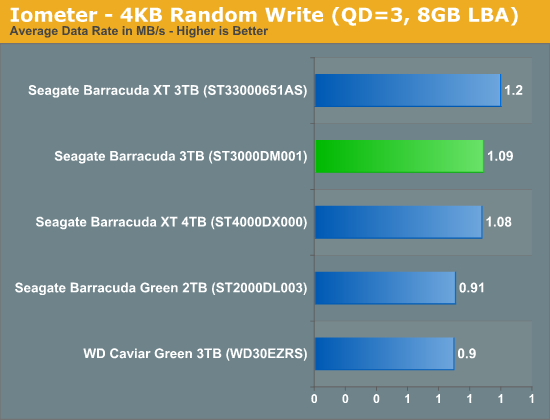
Random write performance actually dropped a bit compared to the older Barracuda XT. It's still higher than the Green drive, but it looks like Seagate has tweaked the drive's firmware a bit resulting in lower random write performance.

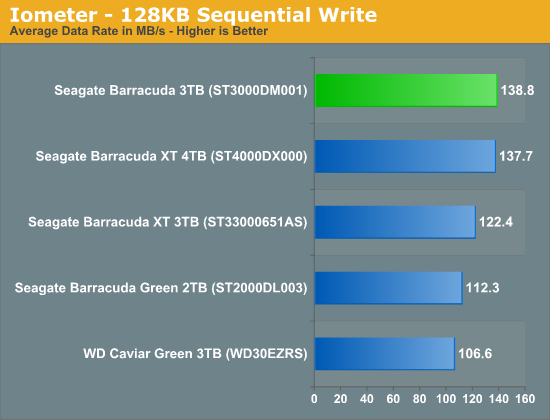
Sequential performance is up a bit over the original 3TB Barracuda XT, but about in-line with what we'd expect from a modern day high-capacity drive. Even compared to the latest 4TB Barracuda XT, we see a slight increase in performance.
Despite the sequential performance advantage, PCMark 7 showed the new Barracuda on-par with the Barracuda XT:
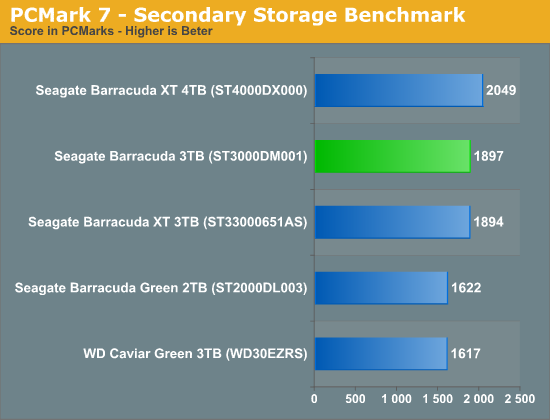
I ran the drives through our light and heavy 2011 workloads from our SSD reviews (which takes absolutely forever to run on mechanical drives) and saw some interesting data:
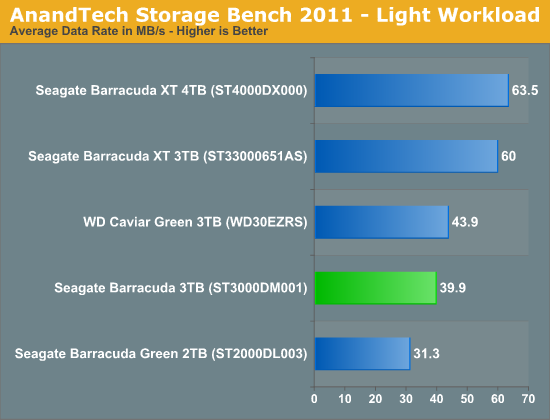

The Barracuda XT was consistently faster than the new 3TB Barracuda in our trace based benchmarks. Keep in mind that both of these tests were created on and for SSDs. Both tests involve a much heavier usage pattern and demand ultra quick response time, likely giving these hard drives an extremely strenuous workout. While the new Barracuda is faster than the outgoing Green, it seems as if the firmware isn't quite as tuned for performance as the XT. The difference does make sense, particularly if it translates into lower power usage given the new mainstream focused Barracuda lineup.
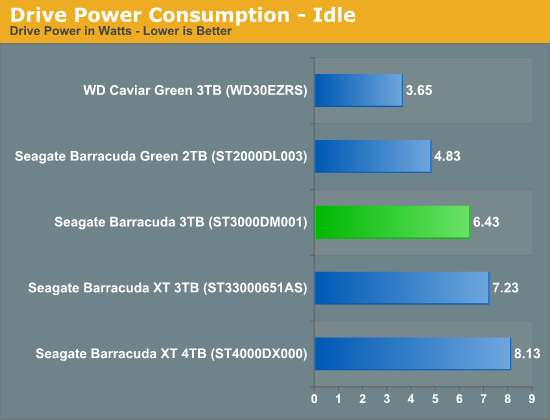
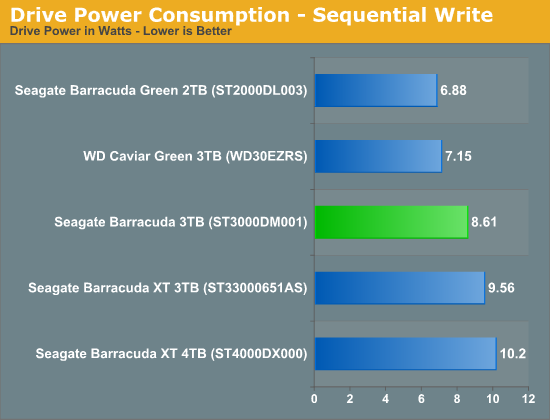
Power consumption is obviously lower than the old Barracuda XT, but still not quite as low as a 5400RPM Barracuda Green or WD Caviar Green. If you were expecting the new Barracuda to completely replace the outgoing Barracuda Green you will be disappointed. It looks like if you need a high capacity, low power 3.5" drive going forward it won't be from Seagate.
Final Words
The new 3TB Barracuda is a bit faster in sequential performance than the old Barracuda XT, at lower power consumption. In typical desktop workloads I think it's fairly safe to say that you wouldn't notice the difference between the Barracuda and Barracuda XT.
As our SSD tests showed us however, when really pushed the new Barracuda performs somewhere in between the old Green and the XT. Seagate appears to have optimized the drive's behavior for lower power rather than peak performance. If you want the absolute best performance out of a 3.5" drive, stick with the XT or wait for the new hybrid version.
Given the tremendous advantage SSDs offer over even the fastest 3.5" drives, I'm personally ok with the performance tradeoff under very heavy load so long as you've got an SSD somewhere in your system as well. I'm not sure I particularly agree with Seagate's decision to abandon the 5900RPM drive market, but thankfully there are other options available if you want a high capacity, lower power drive.




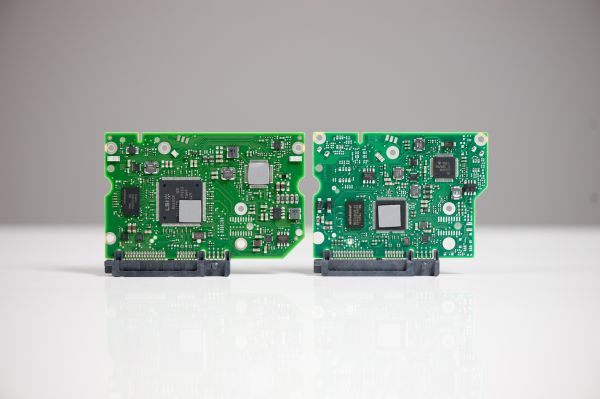
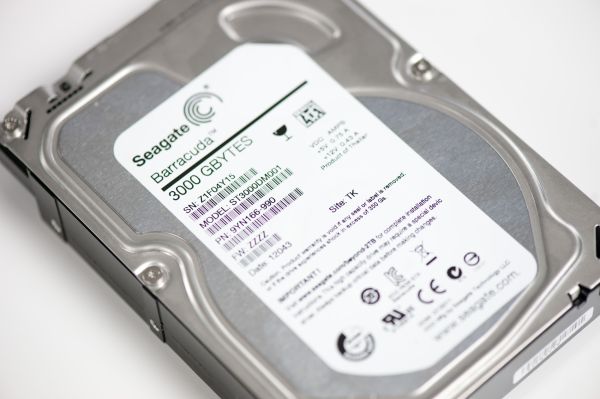








77 Comments
View All Comments
Jaybus - Friday, November 4, 2011 - link
This is normal for any aging technology. These motors are not used in anything else. The market for these motors is not expected to increase, ever, and will almost certainly decrease in the not too distant future. Nobody is going to start up a company to make hard drive motors, therefore there is only one major supplier and a handful of smaller suppliers that could not produce enough on their own. It will become more and more a niche market, just like cathode-ray tube suppliers. It's not that there won't be demand for some time to come, but rather that the demand will never again grow. There is no more room for growth in the hard drive market in general, so not much incentive for new suppliers, or for current suppliers to expand.BlazeEVGA - Thursday, November 3, 2011 - link
I think you meant to say, more than a 2x increase in price - which translates to a 100%+ increase in price.That said, the hard drive industry is a hard-pressed commodity industry (you can blame the OEMs for the drive the price into the ground nonsense...) that has been looking for an excuse to shake up historical tpricing rends. I agree with most that these supply/demand price drivers are actually gouging but the on the flip-side, storage has been almost TOO crazy cheap for far too long. Just think how much tech (layers) go into storage, how much realibility is expected to perserve data & deliver performance and then compare that to how much you pay for an iPod, iPwn or HDMI cable and ask yourself - what gives?
BlazeEVGA - Thursday, November 3, 2011 - link
That said, the hard drive industry is a hard-pressed commodity industry (you can blame the OEMs for the drive the price into the ground nonsense...) that has been looking for an excuse to shake up historical pricing trends. I agree with most that these supply/demand price drivers are actually gouging but the on the flip-side, storage has been almost TOO crazy cheap for far too long. Just think how much tech (layers) goes into storage, how much reliability is expected to perserve data & deliver performance and then compare that to how much you pay for an iPod, iPwn, HDMI cable or even your monthly phone bill and ask yourself - what gives?Phyltre - Thursday, November 3, 2011 - link
The price has been multiplied by two, but you can't parse that into "more than a 2x increase in price" due to reading conventions. It will be read as "more than a two times increase in price," which taken literally means the same thing as a "200% increase." They both literally say "the price has been increased, by 200 percent" and "the price has been increased more than two times."If a bottle costs, say, fifty dollars and the price undergoes a 200 percent price increase, the increase is 200 percent of the original cost. You then add the increase--the 200 percent of the original value-to the original cost. The original cost and the increase are separate numbers. Much simpler to say that the price has more than doubled, or it's now twice the previous cost.
BlazeEVGA - Thursday, November 3, 2011 - link
Say what?Prices on average have doubled since the flood.
That represents a 100% increase in price or 2x the base (original) price.
The key operative word here is "increase" - as used by the OC.
http://webcache.googleusercontent.com/search?q=cac...
If people are buying at price levels increased by 200% - they are surely being gouged and making hasty purchasing decisions. Not saying there aren't channels pricing hard drives at that level, just saying that 2x (100% increase) is the typical trend.
BlazeEVGA - Thursday, November 3, 2011 - link
The rest of your explanation...no frikin clue.Grizzlebee - Friday, November 4, 2011 - link
I agree with what he's saying, although his wording could be better.I, too, hate when people say something is 3x "faster" when it is really only 3x "as fast", which, of course, is only "2x faster".
BlazeEVGA - Friday, November 4, 2011 - link
Say what?Grizzlebee - Friday, November 4, 2011 - link
3x faster = 4x as fast50% faster = 150% of original
I don't really know of a simpler way to say it.
MamiyaOtaru - Monday, November 7, 2011 - link
"3x faster = 4x as fast"haha you are insane